The UNESCO Intergovernmental Commission held in Morocco in 2023 registered Gujo Odori along with 40 other Bon Festivals as UNESCO Intangible Cultural Heritage.
The Kansui Kakeodori dance of Meiho, Gujo City is included in the application for registration of "Furyu Odori as a Bon event", meaning that two UNESCO Intangible Cultural Heritages were simultaneously created in Gujo City.
Mino City, Takayama City, and Shirakawa Village, which are adjacent to Gujo City, each have significant cultural heritage. The Gassho-style houses of Shirakawa-go is a UNESCO World Heritage Site, while Mino Washi, and the Takayama Festival are UNESCO World Heritage designated Intangible Cultural Heritages. This makes the area around Gujo Hachiman a cultural gathering place that is rare in Japan
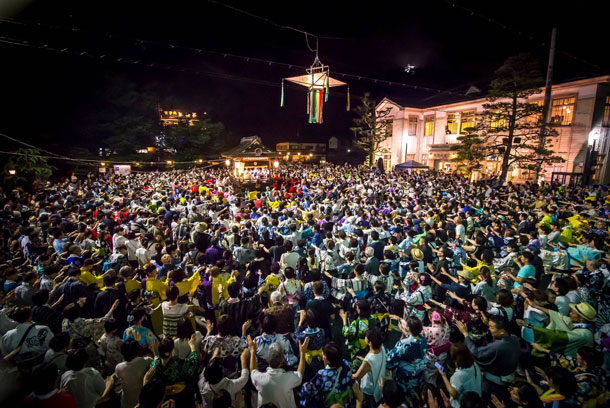
Winter is a magical time. Snow falls in the surrounding mountains and on Shiro Mountain giving everything a fairy-tale feeling.
The restaurants are not overcrowded and there is delicious food to enjoy including piping hot noodle dishes, o'den, and shi shi nabe (wild boar hot pot). Of course local sake brewers do their part to produce new batches of sake that can be enjoyed cold or warm.
Winter also means renewal. End of year parties to say farewell to the old year, and new year parties to welcome the new year.
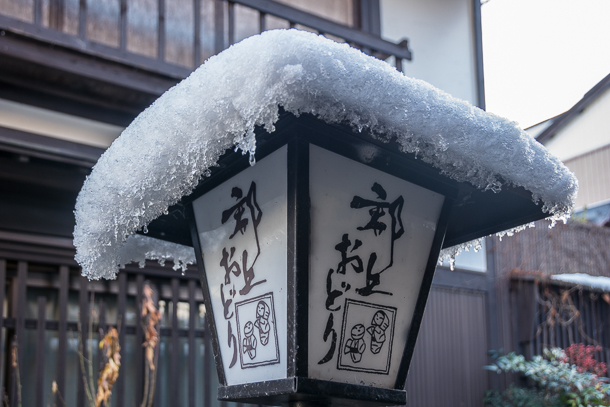
Snow covers a traditional street light.
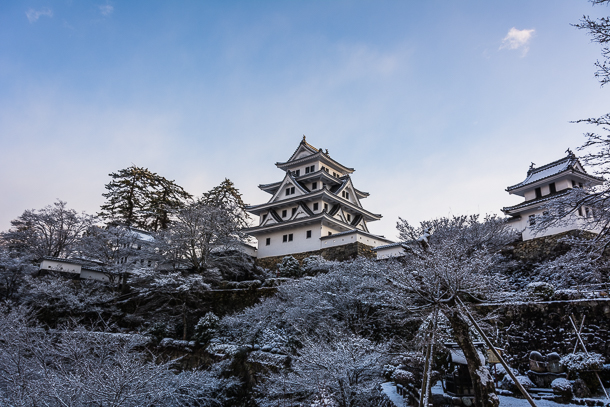
Gujo Hachiman Castle in the morning snow. It is well worth the hike up to see the castle in winter.
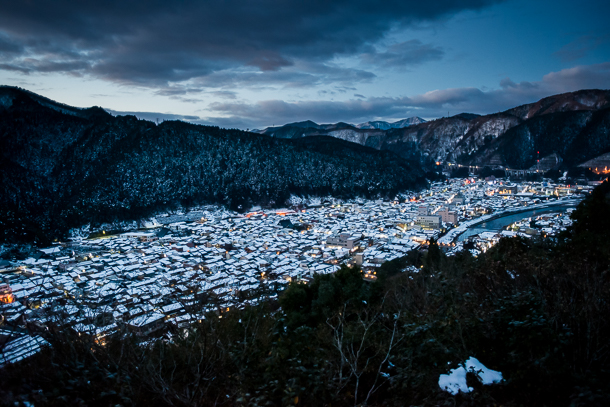
A late afternoon winter view of the town from the castle. A soft glow envelops the town as night approaches.
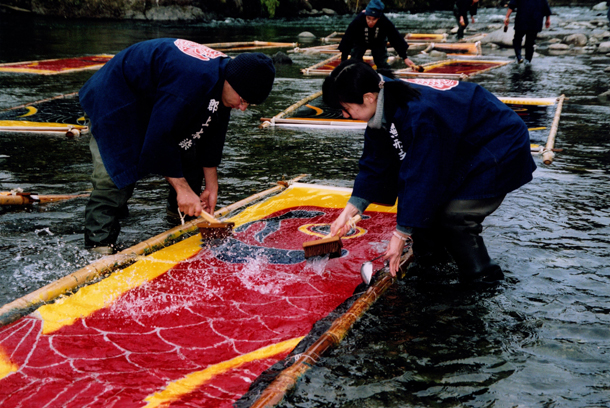
Gujo Hachiman is home to dyeing techniques that have been practiced since 1570. While indigo dyeing is the primary focus, the area is also renowned for producing the koinobori (carp streamers) that grace Japan's skies in May. The manufacturing methods of these streamers have remained unchanged for over 400 years, faithfully passed down through generations.
For example, after the dyeing process is complete, the koinobori are exposed to the clear waters of a river flowing through Gujo Hachiman during the depths of winter for several days. Artisans wade into the icy waters to wash away surface starch and excess dye. This indigo dyeing technique symbolizes the history and culture of the region, with the koinobori production standing out for its unique characteristics.
The wintertime river-washing process is only possible thanks to Gujo Hachiman’s pristine natural environment. It highlights the artisans’ dedication and attention to detail, underscoring the importance of craftsmanship in harmony with nature.
The process of washing the koinobori in the river serves as a symbol of Gujo Hachiman’s tradition and beauty. This winter, the process will be open to the public on the following schedule. It's a wonderful opportunity to see this tradition up close.
1. Open for public Schedule
January 20, 2026 (Tuesday) from 1:00 PM
February 8, 2026 (Sunday) from 10:00 AM
2. Location
Kodara River in Gujo Hachiman (near the city center see map below)
This event is a favourite of both photographers and indigo collectors. and is especially colourful in the snow.
A Google Map showing the location of Koinobori Kanzarashi
If you're not able to visit in January to see the Koinobori Kanzarashi, Mr. Watanabe's workshop is still very much in use today, and his creations are for sale at the back of the store. Mr. Watanabe's work is also for sale in several fine gift stores, including those at the Gujo Hachiman Kinenkan Tourism Centre and the Hakurankan museum.

The Nagara River Basin, which includes Gujo Hachiman, has been selected by Green Destinations as one of the World's Top 100 destinations in 2021!
Nature is deeply connected to Japanese people’s life and ecotourism is a wonderful way of discovering both Japanese culture and landscape. Japan now now its own Sustainable Tourism Standards for Destinations accredited by the GSTC proving the country’s commitment to implementing sustainable tourism.
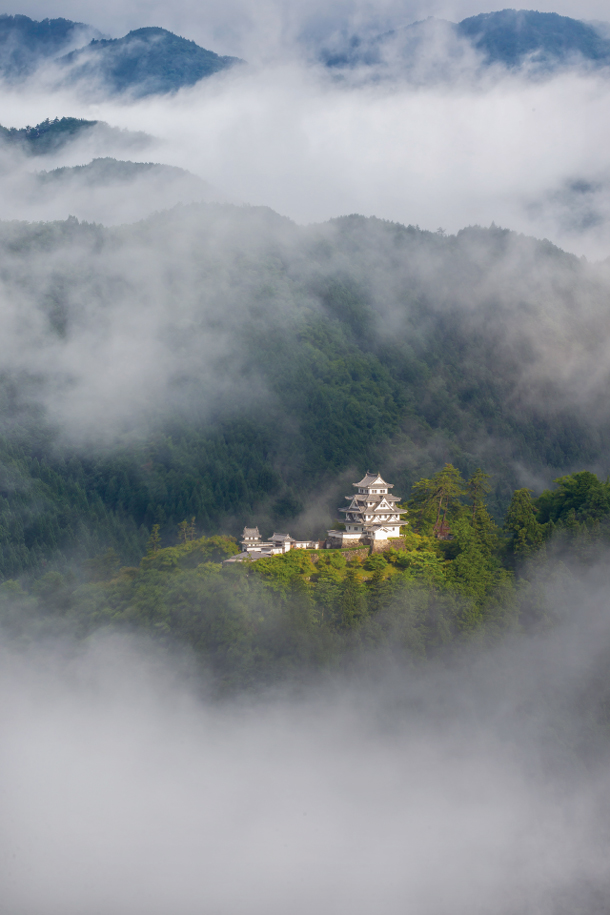
Between October and March mist, sometimes heavy, is often seen in the mountains surrounding the castle creating an ethereal effect when seen from above.
Visit Gujo Hachiman and you can expect to be immersed in an authentic small town Japanese experience unique to an "off the beaten path" town. Here the traditional way of living is on a very human scale. People passing each other in the street still greet each other with a small bow, and exchange a passing greeting.
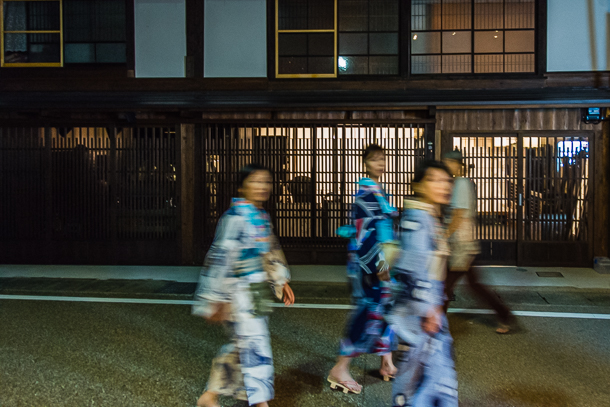
Gujo Hachiman offers visitors a rare opportunity to see, and be part of, a traditional way of life that has changed little over many years.
Visitors to Gujo Hachiman may find the use of English somewhat limited, but can always expect a warm welcome wherever they may go in town.
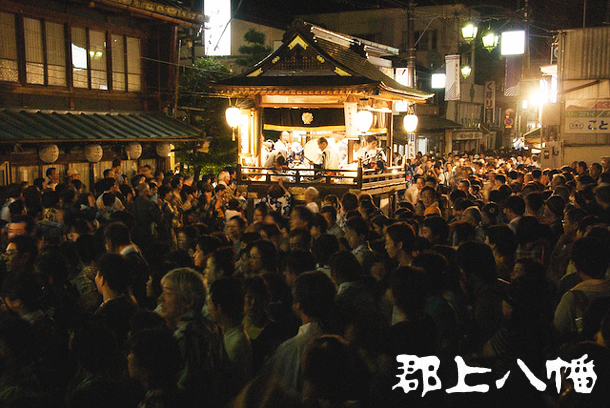
Participate in a unique and accessible Japanese cultural event in a way few foreigners ever get to experience. Dance all night to traditional odori songs like "Kawasaki", "Harukoma" or "Gengen Bala Bala." You can learn more about Gujo Odori here and find the start time and location of each day's dancing here.
You can now particpate in a fully guided Gujo Odori experience with Sugi Interface Studio. More information about this experience, including terms and prices can be found here.
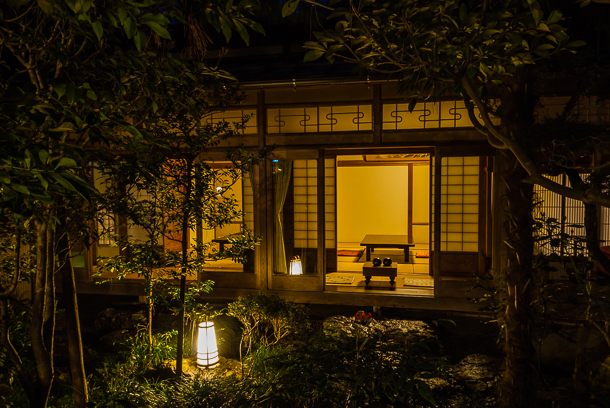
Enjoy a truly authentic traditional ryokan or minshuku experience at any of the many ryokans or minshukus listed on the accommodation page. All these ryokans or minshukus are small, intimate, and family run. The Gujo Hachiman Kinenkan Tourist Centre can help you find the one that's right for you. Please note that accommodation during the Gujo Odori season is best booked well in advance. Learn more about surprisingly affordable ryokan and minshuku accommodation in Gujo Hachiman.
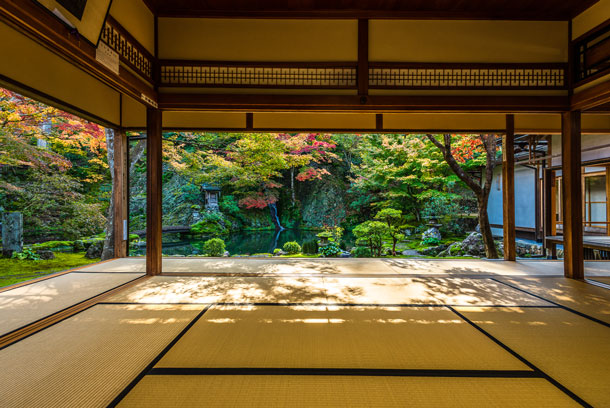
The Japanese garden at this small temple is simply magnificent. But more importantly, it is peaceful, soul restoring, and uncrowded. Be sure to listen for the "suikinkutsu" or "water harp cave". While the autumn colours are stunning, the other seasons also have their charms.
You can learn more about this beautiful temple and its garden on our Temples page. You will also find a link to Jion Ji's official website there.
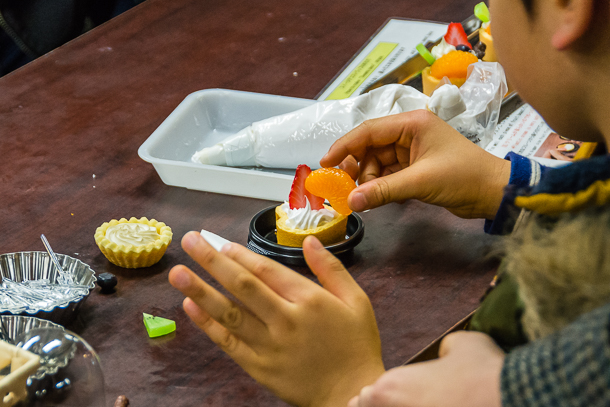
Few people know that the ubiquitous plastic food sample seen outside virtually every restaurant in Japan was invented in Gujo Hachiman. Visit the place were 70% of Japan's "food samples" are made. Be sure to try your hand at making your very own lettuce leaf or shrimp tempura sample! Learn more
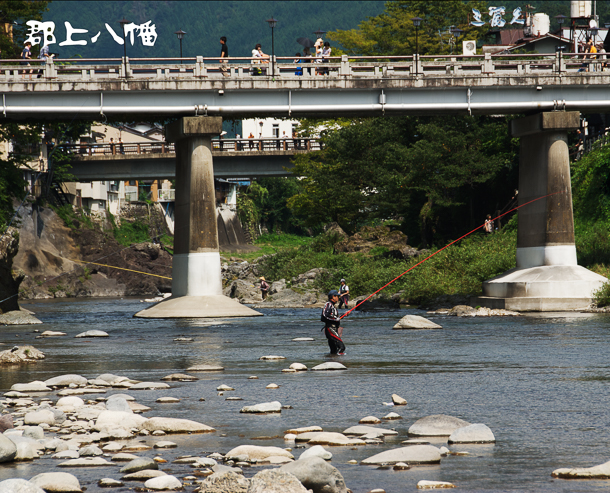
For a truly unique experience, wade into the Yoshida or Nagara River and try your luck at catching your dinner (A permit is required but easily obtained)! For the less adventurous, be sure to try this gourmet treat in restaurants around town! A local can point you in the right direction.
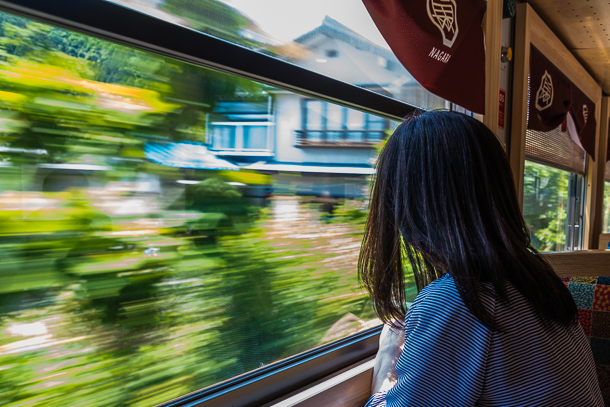
Named as one of the 5 Must-Ride Local Lines in Japan, a ride on the Nagara River Railway is a trip back in time to when travel was exciting but relaxing, and the views from trains were unmatched. The small "one man car" trains of the Nagara River Railway offer practical, relaxing, and hassle free transportation for visitors seeking to reach Gujo Hachiman from Mino Ota. And starting April 2016, the week-end only specially designed all first class "Nagara" offers a unique "not to be missed" rail experience daily between Mino Ota and Gujo Hachiman. Learn more about this unique rail service.
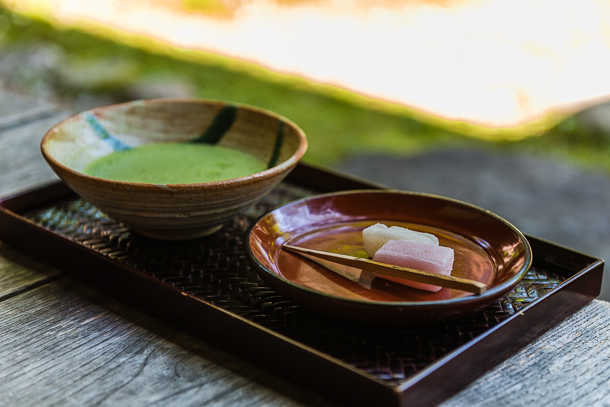
Gujo Hachiman offers a unique alternative to the hectic and sometimes overwhelming urban experience that Japan can be. It's a chance to collect your thoughts, reflect upon your amazing journey, and to connect with Japanese people, customs, and experiences that are unique to a small town.
Buses to Gujo Hachiman will now depart only from bus stop number 14 at JR Gifu Station. (This is located roughly in the center of the image below.)
If you are coming from Nagoya using the Meitetsu Line please be aware that the distance between Meitetsu Gifu Station and JR Gifu Station bus stop, which involves crossing over a major traffic intersection, may be inconvenient if you're carrying large suitcases or luggage. (See image below)

We recommend using the JR Tokaido Line when traveling from Nagoya for an easier transfer to the Gujo Hachiman Highway Bus.
We recommend the following route for those using the airport express from Chubu Centrair International Airport: Chubu Centrair International Airport (Meitetsu) → Kanayama (Meitetsu), transfer to the JR platforms, and then Kanayama (JR) → Gifu (JR). This will require purchasing a Meitetsu Ticket at Centrair to Kanayama and a JR ticket at Kanayama to complete the journey to Gifu.
Additionally, starting October 1st, the final stop for the Gifu Bus Hachiman Line will be "Gujo Hachiman Station." instead of Hotel Gujo Hachiman.
First-time users please note that the "Gujo Hachiman Jokamachi Plaza" stop is closer to the city center and more convenient for transfers and sightseeing, Please take care when choosing your stop.
This convenient pick-up service is timed to connect with the highway bus services offered by Kintetsu, Meitetsu and Nohi Bus companies. Gujo Hachiman is an intermediate stop on highway bus lines that serve Hida Takayama making it easy for visitors to stop off in Gujo Hachiman on the way to or from Hida Takayama.
A map showing the location of the highway bus stop. Click on the "View Larger Map" icon to open in Google Maps and navigate using Google Maps
Important: The highway bus stop is located along the Tokai Hokouriku Highway, approximately 2km out of the centre of town. Advance reservations are required BEFORE your highway bus departure from Nagoya, Takayama or Osaka. Fee : 350 yen
To make a reservation please call: 0120-053155 (9:00am~5:00pm )
Please refer to the pick-up service time table for bus arrival and departure times.
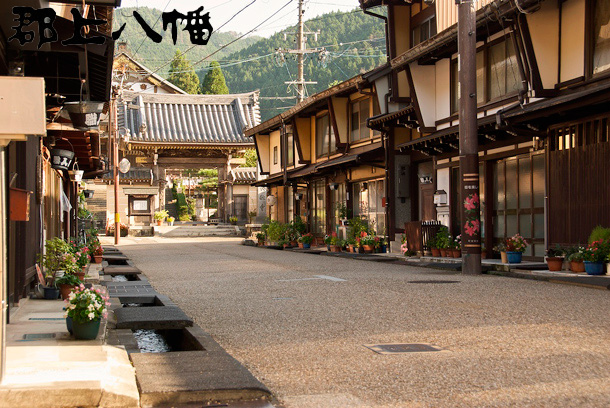
A view of Shokunin Machi looking towards Chokyou Ji temple.
The Japanese National Government, in 2013, designated 14.1 hectares in the centre of the central historic district as an "Important Preservation District for Groups of Historic Buildings." Specifically the buildings along Ote machi, Shokunin machi, Yanagi machi and Kajia machi. Visitors can easily find, and visit this historic area which surrounds the central Jokamachi Plaza. Download our free self-guided Historical Visit tour and map.
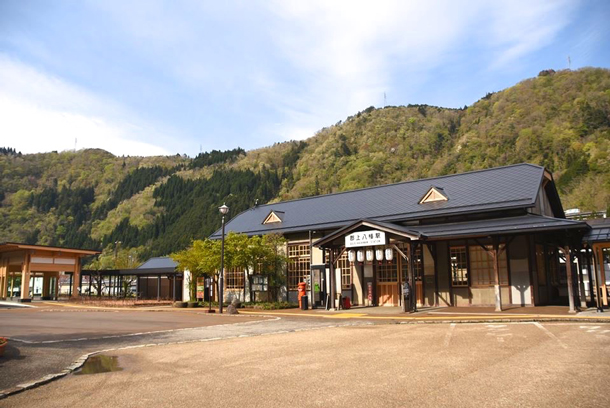
A view of Gujo Hachiman Station which was restored in 2017
The Japanese National Government has designated Gujo Hachiman Station, built in 1929, as an Important Cultural Property. The designation covers the station building, the platforms, and the bridge between the two platforms. The station is owned the Nagara River Railway and is part of the Samurai Line. You can visit the Samurai Line's Facebook Page to learn more about this rail link the joins Seki, Mino and Gujo Hachiman
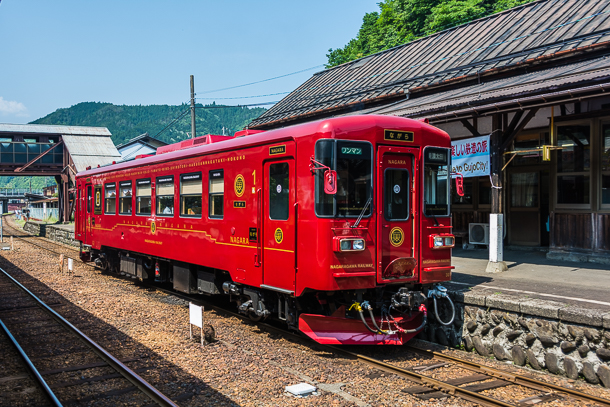
A Nagara River Railway train pauses at Gujo Hachiman Station on its way southbound to Mino Ota.
 It is easy to visit all the key sights and places in Gujo Hachiman on foot in one day. Overnight visitors may especially appreciate the calmness of the town in early evening and morning.
It is easy to visit all the key sights and places in Gujo Hachiman on foot in one day. Overnight visitors may especially appreciate the calmness of the town in early evening and morning.
Download our Free City Map and start planing your visit!
You can also take a free self-guided tour. Download the free map and walking tour directions. Allow about 2 hours for the full visit which includes the historical centre of town. A self guided river walk tour is also available for free download. It's the perfect way to experience Gujo Hachiman in the Spring and Autumn.

Everyone is welcome to learn Gujo Odori. The Gujo Hachiman Hakurankan hosts daily Gujo Odori lessons in the two most important dances - Kawasaki and Haru Koma. The pace is relaxed, entertaining and easy to follow. Those wishing to simply observe are also welcome.
When: Please check the website below for Gujo Odori lesson and demonstration times.
Where: Gujo Hachiman Hakurankan, Tono machi near to Jokamachi Plaza
Adult Admission:520 JPY Children 310 JPY. Entry to the gift shop is free. Open daily except for New Year's holiday.
Visit the Website - English and Japanese
Catch up on our latest Facebook posts. You can also Like Us on Facebook and keep up-to-date on all the latest news.
Note: This feed from our Facebook news feed will not display in browsers with content blocking is enabled.
Here are some of the latest images from our Instagram feed.
Visit us in person:
Kinenkan Tourism Centre
501-4222
520-1, Shimadani,
Hachiman Cho,
Gujo Shi, Gifu ken,
Japan
Hours:
9:00 am - 5:00 pm daily
9:00 am - 6:00 pm during Gujo Odori season
Phone: 0575 67-0002
Access our self-serve media/press image gallery
HACHIMANCHO SHOKUNINMACHI WEATHER